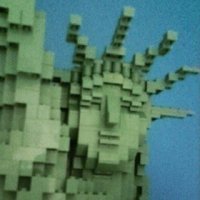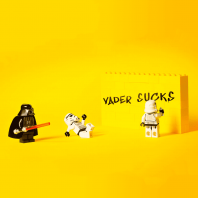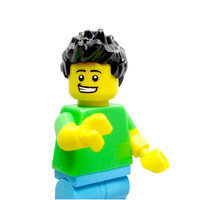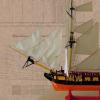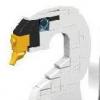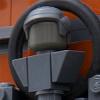Search the Community
Showing results for tags 'Renaissance'.
Found 14 results
-
My entry for Summer Joust 2022 - Gradients category. I chose brown colours. (Brown, Reddish brown,Medium Nougat and Tan). Inspired by medieval/renaissance townhouses from the Baltic area. Hope you like it
- 10 replies
-
- medieval
- renaissance
-
(and 1 more)
Tagged with:
-
This is a MOC I created first in LDD, then in real life (thanks BrickLink!), featuring four attractions at a Renaissance Faire/Festival. I wasn't sure whether to post it in this forum or City (since technically it would take place in modern times), but figured its elements would appeal more to Historic fans. You can find many more pictures on my Flickr page. Also, I have submitted this as a project on Lego Ideas, so if you feel so inclined, I'd love your support: https://ideas.lego.com/projects/131376 C&C are always welcome and appreciated! Thanks, Lindulan Overview of the whole group: 1 - Renaissance Faire by Lindulan Halcyon, on Flickr The concession stand, with half-yards of lemonade and smoked turkey legs: 2 - Concession stand by Lindulan Halcyon, on Flickr The stage, where a minstrel plays his lute: 4 - Stage by Lindulan Halcyon, on Flickr Shooting gallery with stud-shooting crossbow: 5 - Shooting gallery by Lindulan Halcyon, on Flickr Souvenir tent with removable roof and lift-up side flaps: 7 - Souvenir tent & roof by Lindulan Halcyon, on Flickr
-
Hi all, I'm very happy to introduce my latest modular building, coming after long months of university activities hijacking my free time. The set houses a leather shop in the far right building, inspired by Renaissance architecture, an empty house in the far left one, just sold to a new tenant, and a 13th century watchtower in the middle. Hope you like it!
- 11 replies
-
- renaissance
- italy
-
(and 3 more)
Tagged with:
-
Renaissance building Inspired by: Rosenborg Castle in Copenhagen, Denmark (built in 1606-1633) Børsen in Copenhagen, Denmark (built in 1619-1640) Green Gate in Gdańsk, Poland (built in 1564-1568) This building is a part of a series of 21 buildings built in different architectural styles. Each building is built on one 32x32 baseplate: https://www.flickr.com/photos/66344850@N06/albums/72157708211032315
-
The School of Athens (Scuola di Atene) is one of the best pieces of art in the history of humanity, here's the Lego version: The School of Athens was completed in 1511 and is not only considered Raffaello Sanzio's finest work, but also the work that sums up the spirit of the Renaissance. My brother has struggling to finish this project properly and almost set it aside and gave up. I took it over and finished it in a smaller scale. Why "The School of Athens"? With so many sets based on movie and on pop culture, we thought it was only right to give art in the traditional sense a chance at becoming an official product. For us, this painting represents humanity, explicitly and implicitly. Just at first galnce, some aspects of human knowledge are visible: architecture, painting, sculpture, philosophy, anatomy, cosmology, but also things inherent to the work: manual rendering of materials and surfaces, colour theory or the perspectives that became so common around then. But the fun of it are the layers of extra meaning it bears. The figures stand in certain angles, perpetually braking the symmetry, linking geometry to the real world. Raphael crafted the characters so they are immensely expressive and vital; they really do feel alive, something I feel my brother has also achieved, they interact, they discuss, they disagree, they agree, they are typically human: they cooperate with one another, something the ancients can teach us. I believe this is not a mere fresco, it is a piece of art that can teach us. Who is who? Represented here are some of the most important philosophers, mathematicians and thinkers of ancient Greece, Rome and even muslim Spain. Some of the statues are pagan gods and some of the figures have the faces of eminent Renaissance figures, with Heraclitus having Michelangelo's face, Euclid having Bramante's face and Apelles having the painter's face, all in all, a nice mix, something that also applies to today's multicultural cityscapes. Video: Fun facts about the Lego model: Originally the plan was to give the 1x1 brick with 4 studs on the sides to the women in the painting and the Erling brick to the men, but my brother ended up giving the 1x1 brick with 4 studs on the sides to male figures too, as the Erling brick didn't allow for side hair. The compass Euclid uses are some cherries. The only Olive Green pieces in the whole model are for Socrates, the originator of what today we understand as "philosophy" (the philosophers before him are today known as "pre-Socratics". The robes next to Diogenes are regular Lavander, nor Medium Lavander like the rest of the robes in the rest of the model. Only women wear Aqua garbs.
- 9 replies
-
- heraclitus
- diogenes
-
(and 12 more)
Tagged with:
-
For the Summer Joust team category this year, the challenge was "Just Another 'Normal' Day." My team decided to go with Leonardo da Vinci! The scenes we covered were inventing, sculpting, painting, and, of courses, sleep. All four of us built fully immersive scenes, with some fantastic editing from Jonah to finish them off. Here's my part. I did a street corner of a Tuscan-inspired village. Now, I understand the scene isn't historically accurate. Leonardo never really finished any of his sculptures (at least that we know of), but liberties were taken for the sake of the collab :) Here's an overview of the four parts: Check out all the other parts! I was honored to be able to work with Joe, Jon, and Jonah, three fantastic builders. Part I: Invention by Jon Part II: Sculpture by Kevin Part III: Fresco by Joe Part IV: Relaxation by Jonah
- 17 replies
-
- renaissance
- italy
-
(and 2 more)
Tagged with:
-
This is a model of an Italian style galley. 14th century, 1571 or mid. 18th century depending on weight on references or type. In the Mediterranean in medieval times, the galley was almost synonymous with a warship. These ships made up the principal warships of the major fleets in the area. Being high-speed vessels, they were also used to chase down pirates. The type had a late revival in the Baltic were it was used primarily in the conflicts between Russia and Sweden. It is in minifig-scale or 1:40’ish. The model will have the dimension Length: 166 cm, Height: 113 cm (with stand), Width: 82 cm (with oars) There is approx. 16200 bricks in the model. The galley, true galley or gallee sottili was developed during the 13th and 14th century and the design remained the essentially the same until it was phased out in the early 19th century. The main characteristics of the model are from La Capitana, a galley of Malta. The lines, armament, oars and overall arrangement follows the drawings of this ship. These are indexed in Architectura novalis mercatoria (published by Fredrik Henrik af Chapmann in 1768) as: no.18 on plate LVIII Details, such as color, not provided by Chapmann, are from Real, the flagship of Don John of Austria in the Battle of Lepanto in 1571. In 1971, to commemorate the 400th anniversary of the battle, a full size replica of La Real was built and displayed in the Barcelona Maritime Museum where it can be viewed today. This also gives an abundance of accurate picture material to work from. The details from this Spanish Real compared to the French La Réale from 1694; however, this ship is not a main reference. A sidenote on the names of the ships: “Capitana” was the term used for the largest and most prestigious ship of a squadron carrying its commander. “Real” or “Réale” just indicated these ships as being Royal, or as the main galley of the kingdom/fleet. This made me wonder: Did these ships have other more common names? -at least among the sailors. The doctrine of the galley was brutal. The ships would take position abreast and then get on the enemy as fast as possible to engage in melee combat. This largely dictates the design of the ship. Sleek with 60 oars and some 300 oarsmen, this is a thing built for speed. The main battery is at the bow, where the main battle would take place. This is also the only armament that is in the linedrawings. These guns were fixed and would only shoot once just before boarding. This may seem strange, but a galley would cover the effective distance of artillery pieces much faster than the reload time. I have placed the remaining guns, consisting of 2-pounders and pivot guns, along the side where I figured it made sense. A boat is starboard. This feature is not on the Linedrawings, but is on the other references as well as on several other galleys, so I figured it to be a galley-thing. The commander would have his place at the stern. In front of the commanders quarter is a deck space where additional soldiers, delivered by support ships, were organized.
-
The Carrack, Caravela, Nau, Nao, Neef or Kraak. The ship type was all the rage in the 15th century. It was important for me that it seemed like a reasonable evolvement of the cog, and as a precursor for the galleon, being closer to the latter. Trying to avoid the most out there designs of this type; I have mainly used different plans for the Santa Maria and a great deal of sense. It is in minifig-scale or 1:40’ish. The model will have the dimensions Length: 85 cm, Height: 75 cm (with stand), Width: 23 cm (Beam) There is approx. 6400 bricks in the model.
- 4 replies
-
- columbus
- santa maria
- (and 11 more)
-
Hi everybody, my name is Pierluigi, aka Cloudstrife84, i’m from Italy and aftter months of hard work, I finally realized my Lego Ideas project. Help me make it a reality. Come look, ask if you like my idea and if you want to see my set realized, supported and share it a lot. Supported and share. Thank you very much. The Mankind Machine Relive the most important historical facts of Mankind with this Lego Set divided by past eras. Discovering the history of man has never been so much fun!!! Hunt the Mammoth with the Neanderthal man, dominate Ancient Egypt with the Pharaoh, fight with the Roman gladiators or assault the castle in the Middle Ages. Why don't discover the glories of the Italian Renaissance with Galileo or land in the New World with Christopher Columbus? Help the sheriff of the Far West or allied with Indians. Defend the Japanese Emperor from the attack of ninjas or participate in the taking of the Bastille during the French Revolution. You will be able to do all this and much more thanks to the Laboratory that allows you to travel through Time to relive the most important facts that have characterized the Mankind History. Detailed interchangeable Lego Sets that can be assembled in the central Laboratory. You choose the Sets with your favorite eras or collective all to retrace the exploits and events of man through time. Each Set is composed of about 500 Lego pieces and contains 4 mini-figures representing important and characteristic characters of the time expressed in the Set. Each set can also be closed to form a pretty box. I have always loved time travel and I think I am not the only one who would like a Lego Set that reproduces in a comfortable, pratical and beautiful to see, various historical eras. Perfect, then, in my opinion, both to stimulate the imagination of children, who learn the most important stages of Mankind while playing, and for adults who want to collect all the Sets, thus having at home a perfect reproduction in Lego of the fantastic History of Man!!! Hope you like this Idea. Hope you have a great 2019, see you next year. Thanks. https://ideas.lego.com/projects/cb9bf39a-9b21-4c56-b89e-8e7890e556ec https://ideas.lego.com/projects/f301e049-a5c2-4784-bfe3-16176b050330 https://ideas.lego.com/projects/dd207669-1ee1-4819-830e-ba51ed13f78e
-
- mankind
- time machine
- (and 14 more)
-
Reserve a table at the Florentine Steakhouse! Customers can choose high quality meat from the Butchery and then taste it in the Steakhouse, inside or in the romantic loggia. It features an old couple's three floor house as well. Hope you like it guys and appreciate Italian style! And if you wish to build it and support my activity, just check it out HERE!
- 37 replies
-
- modular building
- italian
-
(and 2 more)
Tagged with:
-
Rosenborg Castle is a renaissance castle located in Copenhagen, Denmark. It was built by the famous Danish King Christian IV. The construction started in 1606, and after several expansions the castle was completed in 1633. My LEGO model of the castle shows it in the 1630s when the castle was new and Christian IV lived there. Christian IV is one of the most famous Danish kings. He was born in 1577 as the oldest son of King Frederik II. At the death of his father in 1588 the 11-years-old Christian became king of Denmark and Norway. He is frequently remembered as one of the most popular, ambitious, and proactive Danish kings, having initiated many reforms and projects. Many of the most famous buildings in Copenhagen was built during his reign. But he also engaged Denmark in numerous wars which undermined the Danish economy. He also had more than 20 children with 5 different women. Christian IV died in 1648. His reign of almost 60 years is the longest of all Danish monarchs. More photos of my MOC: https://www.flickr.c...157653867511784 More information about the castle: https://en.wikipedia...osenborg_Castle
- 21 replies
-
- Copenhagen
- Denmark
-
(and 1 more)
Tagged with:
-
Top of the morning to y'all... New published project in https://ideas.lego.com/projects/93125 for you to support should you want to :) Leave feedback and considerations regarding this MOC. Thanks! Cheers.
-
Not sure if I'm posting this in the right section... Although I signed up to Eurobricks ages ago, I never really posted anything up here. it's quite historical (although parts of it are still medieval, it is set in the 18th century). It doesn't really fit in the "LEGO historic themes" section in my opinion. It's not a pirate mod either, since it's based on a real building and I'm pretty sure Dordt never had a pirate harbor :-) So I put this into town, but if I'm wrong, please put it on the right spot :-) Groothoofdspoort, Dordrecht Some time ago my colleagues in Dordrecht asked me if I could build something from their city. They offered me a challenge to recreate one of Dordt's landmarks: the Groothoofdspoort (one of the two remaining city gates). It is located at the river Beneden Merwede, at the point where it continues as river Noord and river Oude Maas. It was built in the late medievals, but altered in 1618 (facades), 1692 (dome) and 18th century (rococo ornate gate at the river side). The house between the harbor entrance and the gate were built in the early 17th century after narrowing the harbor entrance. The house at the other side of the gate was built with it's back leaning against the city wall. Since the current setting (2014) isn't my favorite one with a big grey hotel at one side of the gate, I started searching for historic pictures in the city's archives and found several ones from the 18th century showing some Dutch renaissance facades and a nice kitchen annex with columns instead of the hotel. The street plan was taken from the first proper cadastral map from 1830, still showing the 18th century situation. Most fun was recreating the diagonal parts in the building lines. Only three buildings have square floor plans. One of the houses got only one 90 degree angle. pj_bosman 2014-05-11 Groothoofdspoort reference pictures 7662 by patrick_bosman, on Flickr pj_bosman 2014-05-11 Groothoofdspoort 7551 by patrick_bosman, on Flickr More pictures here Thanks for reading :-)
-
Often it can be difficult to decide what I want to build. The Collectible Minifigures theme has brought many interesting historical minifigures. Last year I have built a large Greek layout for the Spartan from series 2: http://www.eurobrick...89#entry1533491 After I had finished the Greek layout I thought a lot about what I should build next. Should I build a Roman layout for the Roman minifigures? Or should build an Egyptian layout for the pharaoh? Or a 1700's layout with a lot of minifigures with white wigs? I would like to build it all. That's how I got the idea to build this MOC: Ancient Egypt: Ancient Greece: Ancient Rome: In the background: Colosseum The Viking Age The Middle Ages: The Renaissance In the background: St. Peter's Basilica in Rome: The Late Renaissance: In the background: Rosenborg Castle: The Age of Enlightenment In the background: Fredensborg Palace: The Industrial Revolution In the background: Westminster Palace: Modern Time: The back of the MOC is a world map:
- 63 replies
-
- Renaissance
- Egypt
-
(and 7 more)
Tagged with:



